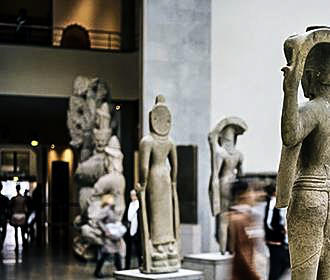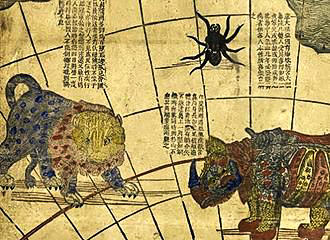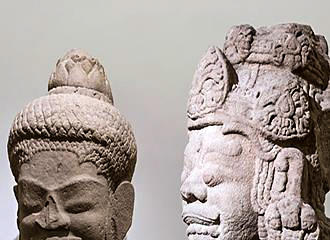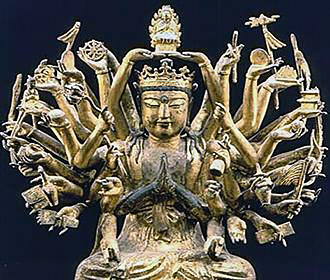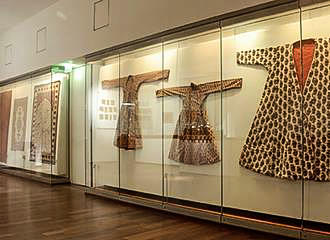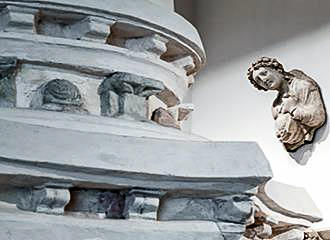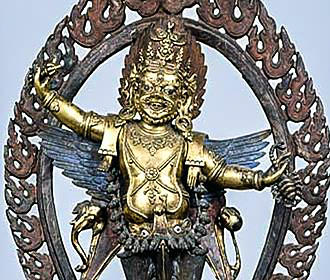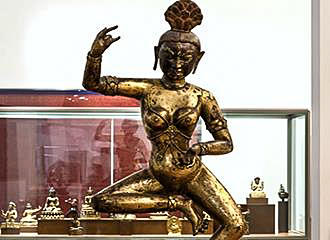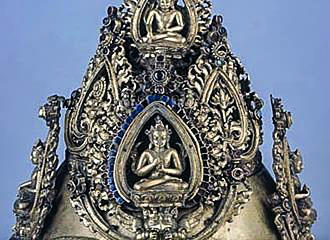Paris Musee Guimet; Musee des Arts Asiatiques Guimet
The Paris Musee Guimet is sometimes known as the Musee des Art Asiatiques Guimet is dedicated to Indian, Japanese, Chinese and Indonesian artefacts and art masterpieces, many of which are thousands of years old.
About Paris Musee Guimet
Now the Paris Musee Guimet, or Musee des Arts Asiatiques Guimet Paris museum, has the widest collection of Asiatic arts in Western Europe, which, when you look back at the history of the Musee Guimet, is in large part thanks to its founder Emile Guimet.
In a completely renovated area that provides far more light, you will be able to discover a rich collection of art and artefacts from India, China, Japan, Indonesia and Cambodia including many masterpieces that were created thousands of years ago.
You will be able discover metal sculptures in the Himalayan section dating from the 11th century along with liturgical objects, bronzes and paintings.
The impressive China section has around 20,000 different art objects with ceramics from the Neolithic period through to bronzes of the Shang and Zhou dynasties, plus mirrors, lacquers, vases and much more.
The India section has displays of sculptures dating from the third millennium BC, an impressive array of jewellery and miniature paintings from the 15th century.
Yet the Paris Musee Guimet, or Musee des Arts Asiatiques Guimet, Japan section also has an impressive amount of around 11,000 objects or art, which include ivory, stoneware and porcelain, sculptures and paintings on silk, and a lovely range of silks and other textiles.
There is an entire section dedicated to textiles and Musee Guimet has one of the most comprehensive collections in the world, with its scientific and historical importance, there are tapestries, costumes, dresses and other garments, embroideries, printed fabrics and much more dating back to BC.
The Paris Musee Guimet, Musee des Arts Asiatiques Guimet also has a dedicated music section that was first founded back in the 1930s, which has been able to preserve some of the oldest of Asian musical traditions, and a sound library was formed for this purpose.
There is also a photographic archive section at the Musee Guimet, which was first founded in 1920 and includes a unique album of the oldest photographs in the museum's collection including writings about Persian miniatures, calligraphy, prints, etc. In addition, there are photographs from the first French archaeological missions.
A library has also always been present at the Paris Musee Guimet, or Musee des Arts Asiatiques Guimet since it was founded back in 1889, which was the year of a World fair in Paris when the Eiffel Tower was officially opened.
Within the library there are actually over 100,000 volumes in various different languages and as well as these European books, there are fragments of manuscripts, Chinese weather maps, approximately 700 Japanese illustrated books and over 2000 Tibetan books.
You will also find that there are temporary exhibitions held each year on different themes such as one on contemporary Japanese calligraphy, another between March and June 2014 entitled the Lure of East-Asia and Georges Clemenceau and another in February 2018 showcasing armour and ornaments associated with Japanese warrior fantasy.
In addition to all of this, there is a 280 seat auditorium, which provides a wide variety of different events such as film screenings, lectures, music concerts, dance and theatre performances plus much more, in a varied programme organised throughout the year.
Many of these are readily open to the public, although booking is normally required, and there are themed events that run alongside the temporary exhibitions being held at the time, but to find out more you can contact the auditorium section of this museum in Paris by telephone on +33 (0) 1 40 73 88 18.
You will also find that there is a cafe style restaurant at the Paris Musee Guimet named Salon des Porcelaines, which in English is the Salon of Porcelain, and has different porcelain artefacts on display. This is open at the same times as the museum where you can enjoy a wide variety of different beverages and snacks, but can only be accessed with a valid museum ticket.
The Paris Musee Guimet also organises guided tours at set times on set days in either French or English and these are an additional cost on top of the cost of entry.
Workshops are also organised on different themes, whether it be a beginner's course or for those that want to learn more about certain artistic techniques, and again these are a separate cost and vary depending upon the type of workshop and duration. However, with either of these, you do have to book in advance due to the limited number of spaces available.
When you look at the history of the Paris Musee Guimet, Musee des Arts Asiatiques Guimet you will find that the Pantheon Bouddhique or Buddhist Pantheon was another section of the museum, but in a separate location, although this has been re-integrated into the Musee des Arts Asiatique Guimet and a new museum based upon tea founded in its place.
Another point we would like to mention, is that the other part of the Musee des Arts Asiatique Guimet is where you can now also discover a Japanese garden along with a Tea Pavillion at this location where you can discover the art of a traditional tea ceremony as well.
Visiting the Paris Musee Guimet, Musee des Arts Asiatiques Guimet
Now the Paris Musee Guimet, Musee des Arts Asiatiques Guimet is open on a Monday and a Wednesday through to Sunday from 10am to 6pm, however, it is always closed on a Tuesday and on all major National French holidays such as 1st May. Also, the day before any bank holiday such as Pentecost the museum closes earlier, plus last entry is one hour before closing time, so it is worth bearing these points in mind before your visit.
The library of the Paris Musee Guimet is open on a Monday and a Wednesday through to a Friday from 10am to 5pm and can be accessed free upon eligibility, registration and proof of identity, whereas the photographic archive section is only open by prior appointment between the hours of 2pm and 5pm.
Spread over four floors, you may be pleased to know this Paris museum is accessible to the disabled and those with reduced mobility, due to the fact there is a ramp at the entrance to the left of the stairs and lifts are in place to access the different rooms and exhibitions.
For those that are sight impaired, adapted visits and descriptive talks are organised along with visits in French sign language for those that are hearing impaired, plus you can also hire a wheelchair, but all of these do have to be booked in advance.
However, we would like to point out that the Buddhist Pantheon, located on the same street just up the road, along with the Japanese Garden and the Tea Pavilion are not accessible to the disabled at this time.
The cost of entry to the Paris Musee Guimet, Musee des Arts Asiatiques Guimet is €8.50 for the permanent collections as of 2018, however, there is a combined ticket for both the permanent collections and temporary exhibitions, which is a cost of €11.50, although it is free for any person on the first Sunday of the month.
It is free to those aged under 18 and the disabled upon providing valid proof, plus there is a reduced rate applicable in certain circumstances such as for students under the age of 25, people studying specific areas of art, archaeology, etc, but it would be advisable to contact the museum for more information.
Now you may also be pleased to know that there is an audio guide supplied free of charge with price of your ticket for individual visitors, which is available in eight different languages for the permanent collections and includes French, English, Spanish, German, Chinese and Japanese, etc.
Room maps and details are also displayed with the French language along with English as well, plus the entire museum is air conditioned, which makes this an even more pleasant Paris tourist attraction to visit.
Group visits are also catered for, with a maximum of 20 people at a time for temporary exhibitions and 30 people for the permanent collections, but these do have to be booked in advance, and a reduced rate is also applicable.
Whereas if you wish to enjoy a film, this is a cost of €5 as of 2018. Conferences or workshops are also charged different rates, depending upon what they are, which is the same scenario for shows that are organised within the auditorium, and again you would need to contact the Musee des Arts Asiatique Guimet for more information and prices.
Acess to the Paris Musee Guimet, Musee des Arts Asiatiques Guimet
Now when it comes to getting to the Paris Musee Guimet, there are numerous different modes of public transport in Paris that you can utilise, especially considering it is located close to the Place des Etats-Unis, the impressive Jardins du Trocadero and the Eiffel Tower.
So, when it comes to reaching this impressive museum via Paris public transport, you will find that the nearest metro station is called the Iena stop serving line 9 where you arrive only a few steps from the museum.
Alternatively, if you are travelling via the Metro line 6 you would need the Boissiere stop and walk down the street to the Square Boissiere Iena, yet if you are travelling on the RER trains, you would need train station called the Gare du Pont de l’Alma stop serving RER C line, which is located on the opposite bank of the River Seine close to the Musee Quai Branly and the Musee des Egouts.
The Paris bus lines 22, 30, 32, 42, 63, 72, 80, 82 and 92 along with the Noctilien Night Bus Service via line N53 will all get you within walking distance of the Paris Musee Guimet, Musee des Arts Asiatiques Guimet and numerous other Paris tourist attractions, as will the Batobus water bus that travels up and down the River Seine and has a stop right by the famous landmark the Eiffel Tower.
